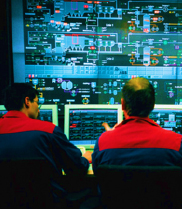SOLUTIONS
Human Factors Engineering (HFE) and Ergonomics
Walter Bennis says "the factory of the future will have only two employees, a human and a dog. The human is there only to feed the dog and the dog is there to bite the human if he or she touches anything" (Paradies and Unger, 2000).
Till the Walter Bennis factory becomes a reality, it will be hard to undermine the role of humans in today’s industrial processes. Unfortunately, several major industrial accidents in the past indicate that human errors are simply inevitable.
A comprehensive understanding of human interactions in an industrial system can enable our clients to not only minimise risk to their people, assets and environment, but also optimise their system performance and reliability.
Supplemented by MES’ proficiency in Process Safety Management and Asset Integrity, Human Factors Engineering solutions provide the necessary assurance and confidence to our clients in ensuring the safety of their People, Assets and Environment.
How can HFE/ ergonomics studies help your business?
Critical Task Inventory & Review
Identifying human tasks which ensure Asset Integrity and/or Process Safety or which could represent significant risks. Critical Task Inventory & Reviews are performed in accordance with best industry practices.
Valve Criticality Analysis (VCA)
Ensuring suitable access is provided to valves based on prioritisation (frequency and urgency of use) of valves.
Human Factor Assessment for Skid Package Units
Ensuring that risks associated with health, safety and human reliability in operations, maintenance of skid packages are As Low as Reasonably Practicable (ALARP).
HFE Plan for Construction
The HFE plan for construction identifies the activities to be performed during the project construction phases to ensure plant / facility achieves the HFE design objectives. The plan will identify the organisation required to achieve, primarily through training, defining roles and responsibilities and quality control activities during construction.
Control Room Ergonomics & 3D Layout Design
Typical consulting solutions on Control Room (CR) ergonomics include:
- Advise on manning levels and job roles for the CR
- Establish task and functional requirements of the areas within the CR
- Evaluate Layout of CR
- Review Layout of the consoles
- Analyse proposed furniture and furnishings within CR
- Review the design philosophy of the main control system e.g. how many screens per controller, use of overview screens etc.
- Assess the adequacy of communications interfaces etc.
To Learn more about how MES’ CFD expertise can help you:
Contact any of our many global offices or fill in the Enquiry Form (see red tab top left). Alternatively, you can write to us at: mes.info@mes-international.com
MES - Minimising Risk, Maximising Performance

SECTOR STUDIES
- Hazard Identification (HAZID) Workshop
- Hazard and Operability (HAZOP) Workshop
- Preliminary Hazard Analysis (PHA) Workshop
- Offshore Activities Risk Assessment Review
- BOWTIE Workshop
- Failure Modes Effects and Criticality Analysis (FMECA) Workshop
- Reliability Operability Maintenance (ROM) Workshop
- Environmental Identification (ENVID) Workshop
- Best Available Techniques (BAT) Workshop
- Safety Integrity Level (SIL) Workshop
- Layers of Protection Analysis (LOPA) Workshop
- Fire and Explosion Hazards Analysis (FERA/FEA/FRA/FEDHA)
- Gas Dispersion and Smoke Ingress (GDSI) Analysis
- Exhaust Vent Study
- Escape, Evacuation and Rescue Analysis (EERA)
- Emergency Systems Survivability Assessment (ESSA)
- Temporary Refuge Integrity Analysis (TRIA)
- Non-Hydrocarbon Hazards Analysis (NHHA)
- Dropped Object (DOS) and Material Handling Study
- Ship/Helicopter Collision and Structural Failure Study
- Transportation Risk Assessment (TRA)
- Blast and Overpressure Analysis
- Topsides/Riser/Subsea/Ship Safety Analysis
- Fire, Heat and Smoke Detection System Design
- Active Fire Protection (AFP) Design
- Passive Fire Protection (PFP) Design
- Fire and Gas Mapping
- Fire Dynamics Analysis/Fire Effects Modelling
- Quantitative Risk Assessment (QRA) for Onshore and offshore Facilities
- Offshore/Onshore Pipeline QRA
- Miscellaneous Risk Assessments (eg. Temporary Buildings, Transportation, etc.)
- Simultaneous Operations (SIMOPS) Risk Assessment
- Cost-Benefit Analysis (CBA)
- ALARP Assessment
- Offshore HSE/Safety Case Development
- Onshore COMAH/CIMAH Report Development
- HSE/Safety Case Updates/Revisions and Bridging Documents
- HSE MS Audits and Reviews
- Hazard and Risk Register Preparation
- Emergency Response Plan (ERP) Development
- Procedures for General Safety, Operations and Maintenance (SOP) Development
- Performance Standards (PS) Development for Safety Critical Elements (SCES)
- Safety Strategy and Philosophy Development
- Onshore and offshore Facilities Surveys and Audits
- Working Environment Risk Assessment (WERA)
- Human Error and Human Factor Study
- Job/Task Hazard Analysis (JHA)
- Study of Human Behaviour during MAE
- Ergonomics Study
- Environmental Impact Assessment (EIA)
- EIA Scoping
- Availability Studies
- Markov State Modelling
- Logistics and Transportation Using "Real Time" Simulation Modelling
- Debottlenecking and Performance Improvement Studies
- Spare Parts Optimisation Studies
- System Performance Evaluations
- Whole Life Cycle Costing Evaluation
- CAPEX and OPEX Economic Calculations
- Risk Based Inspection Services
- Reliability Centered Maintenance (RCM) Studies
- Maintenance Optimisation Studies
- Root Cause Analysis
- Verification and Validation
- Functional Safety Assessments
- SIS Design
- Safety Requirement Specification Development
- Functional Safety Audits
- Fundamentals of Functional Safety Training
- Safety Integrity Level (SIL) Determination Training
- Layer of Protection Analysis (LOPA) Training
- Introduction to Reliability Concepts, Principles and Applications Training
- Advanced RAM Analysis Training
- Reliability Measurement and Improvement Training


